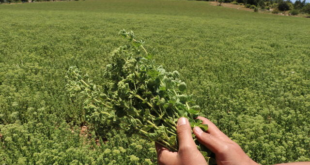Agroforestry Coalition releases recommendations for the Farm Bill, highlights why agroforestry is a priority solution for resilient agriculture…
Coalition outlines steps to remove barriers to adoption for farmers and ranchers and scale up support for agroforestry across federal farm bill programs…

Organizations and experts committed to growing agroforestry as a sustainable farming practice in the US came together to release a set of recommendations for policymakers in a new paper, Catalyzing Agroforestry in the Farm Bill: Recommendations for Resilient Agriculture. Coalition leaders say agroforestry systems, which integrate trees and other perennial crops into farms and ranches, have immense potential to transform US agriculture – boosting farm economies, biodiversity, and resilience to extreme weather while sinking and storing more carbon from the atmosphere.
“Agroforestry is one of the most promising land-based carbon removal pathways. These systems not only deliver carbon sequestration benefits, but also build resilience and boost bottom lines for producers,” said Cristel Zoebisch, deputy director of policy at Carbon180, a co-author of the policy paper. “The farm bill can address key barriers hindering agroforestry uptake across the country and unlock climate, environmental, and economic benefits for agricultural communities.”

Agroforestry is particularly encouraging because it’s a flexible way landowners can achieve conservation benefits while strengthening the productivity of working lands. Consistently ranked as a top climate solution by scientists, adding trees, shrubs, and other perennial plants to pastures or along field edges can build resilience to the impacts of extreme weather. Other benefits of agroforestry include its ability to: increase yield and profit per acre; add more economic opportunities for beginning farmers; protect natural resources; and generate social benefits, such as health and mental well-being.
“Acre for acre, agroforestry is how US farmers and landholders can make the most climate impact, and it works on all sorts of farms,” said Keefe Keeley, executive director of the Savanna Institute, a co-author of the policy paper. “Folks who put the right tree in the right place not only benefit the crops and pastured livestock on their farms, they help conserve our shared resources and foster resilience in our communities.”

While there are many potential benefits that come with integrating trees into agricultural systems, farmers and ranchers face many unique barriers to adoption. Lack of technical assistance, few producer incentives, and the time it takes tree crops to reach full production are just a few barriers identified by the Agroforestry Coalition. The policy paper provides recommendations for each farm bill title that could support more farmers and ranchers in integrating trees into their agricultural systems, plus includes stories from practitioners in Arkansas, California, Illinois, Iowa, Minnesota, New York, Oregon, and Wisconsin.
“Agroforestry could transform the US agriculture sector for the better,” said Kitt Healy, strategy director and lead organizer of the Agroforestry Coalition. “If agroforestry is incorporated into the farm bill, farmers and ranchers will get the information and support they need to integrate agroforestry into their operations, consequently strengthening their resilience overall.”
Source: Agroforestry Coalition
 THE GLOBAL WINDOW OF TURKISH FOOD AND AGRICULTURE The Global Window of Turkish Food and Agriculture Sector
THE GLOBAL WINDOW OF TURKISH FOOD AND AGRICULTURE The Global Window of Turkish Food and Agriculture Sector









